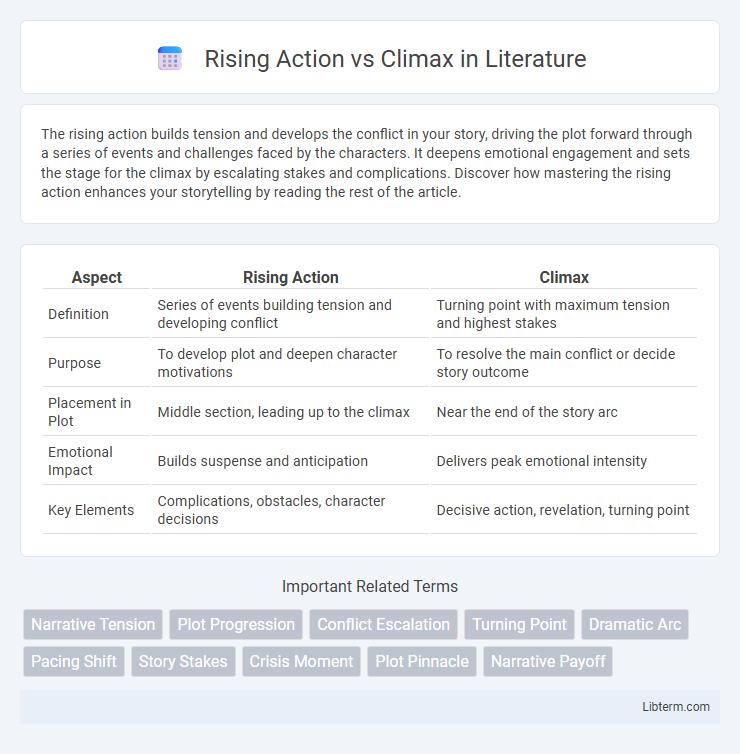The rising action builds tension and develops the conflict in your story, driving the plot forward through a series of events and challenges faced by the characters. It deepens emotional engagement and sets the stage for the climax by escalating stakes and complications. Discover how mastering the rising action enhances your storytelling by reading the rest of the article.
Table of Comparison
| Aspect | Rising Action | Climax |
|---|---|---|
| Definition | Series of events building tension and developing conflict | Turning point with maximum tension and highest stakes |
| Purpose | To develop plot and deepen character motivations | To resolve the main conflict or decide story outcome |
| Placement in Plot | Middle section, leading up to the climax | Near the end of the story arc |
| Emotional Impact | Builds suspense and anticipation | Delivers peak emotional intensity |
| Key Elements | Complications, obstacles, character decisions | Decisive action, revelation, turning point |
Understanding Rising Action and Climax
Rising action encompasses the series of events that build tension and develop the story's conflict, creating anticipation for the climax. The climax represents the turning point or moment of highest intensity where the main conflict reaches a critical confrontation. Understanding the distinction between rising action and climax is essential for analyzing narrative structure and character development in literature.
Key Differences Between Rising Action and Climax
Rising action consists of a series of events that build tension and develop the story's conflict, leading up to the climax. The climax represents the turning point or the moment of greatest intensity where the protagonist faces the main conflict head-on. Unlike the rising action's gradual buildup, the climax delivers the peak emotional and narrative impact that determines the direction of the story's resolution.
The Role of Rising Action in Storytelling
The rising action builds tension and develops characters by introducing conflicts and obstacles that propel the plot forward. This phase deepens emotional investment and foreshadows the climax, ensuring the story's stakes continuously escalate. Effective rising action transforms simple events into a compelling narrative arc that engages readers and heightens anticipation for the story's peak moment.
How the Climax Shapes the Narrative
The climax serves as the pivotal turning point where the central conflict reaches its highest intensity, dramatically influencing the narrative's direction and emotional impact. Rising action builds tension and develops characters, but the climax delivers decisive moments that resolve key plot questions and redefine character arcs. This critical scene shapes the story's outcome, making it essential for driving thematic depth and audience engagement.
Common Examples of Rising Action
Rising action in storytelling often includes conflict introduction, character development, and escalating tension, such as the protagonist facing obstacles or discovering crucial information. Common examples include Harry Potter uncovering secrets about Voldemort, Frodo encountering enemies on the journey to Mordor, and Katniss Everdeen navigating the dangers of the Hunger Games arena. These events build suspense and set up the story's climax, where the main conflict reaches its peak intensity.
Iconic Climax Moments in Literature
Rising action builds tension through a series of conflicts and complications, setting the stage for the story's most intense moments. Iconic climax moments in literature, such as the revelation of Hamlet's mother's betrayal in Shakespeare's "Hamlet" or the dramatic final duel in "The Three Musketeers" by Alexandre Dumas, mark the turning points where the protagonist faces the ultimate challenge. These pivotal scenes deliver emotional intensity and decisive outcomes, defining the narrative's direction and resolution.
Structuring Rising Action for Maximum Impact
Structuring rising action for maximum impact involves gradually increasing conflict intensity and introducing key obstacles that build tension and develop character stakes. Effective rising action strategically escalates challenges to engage the audience emotionally while foreshadowing the climax. Maintaining clear cause-and-effect relationships ensures a compelling narrative trajectory that culminates in a powerful, satisfying climax.
Techniques to Build a Powerful Climax
Effective rising action techniques include foreshadowing, escalating conflict, and increasing tension through character decisions and obstacles. Strategic pacing controls the buildup, balancing moments of suspense with brief relief to maintain reader engagement. Incorporating emotional stakes and unpredictable twists intensifies the climax, making it a compelling culmination of the narrative arc.
Rising Action vs Climax: Common Mistakes to Avoid
Confusing the rising action with the climax often leads to pacing issues, as the rising action should build tension gradually without reaching the story's peak prematurely. Writers commonly mistake a high-stakes event for the climax, but the climax must represent the turning point where the main conflict reaches its most intense moment. Avoid compressing the rising action or diluting the climax to maintain clear narrative structure and maximize emotional impact.
Enhancing Stories by Balancing Rising Action and Climax
Balancing rising action and climax enhances storytelling by building suspense and emotional intensity, ensuring the narrative's flow captivates the audience. Effective rising action progressively develops conflicts and stakes, preparing readers for a powerful, impactful climax that delivers resolution. Mastering this balance creates a dynamic plot structure, heightening engagement and making the climax more satisfying and memorable.
Rising Action Infographic

 libterm.com
libterm.com